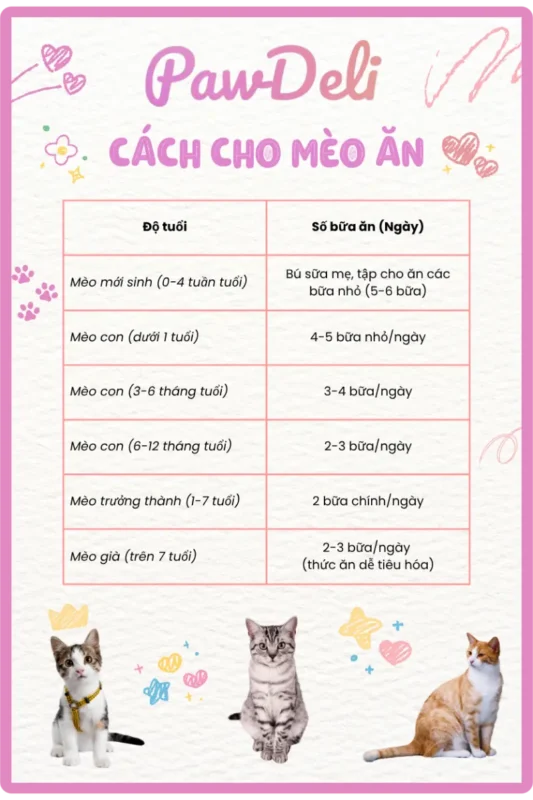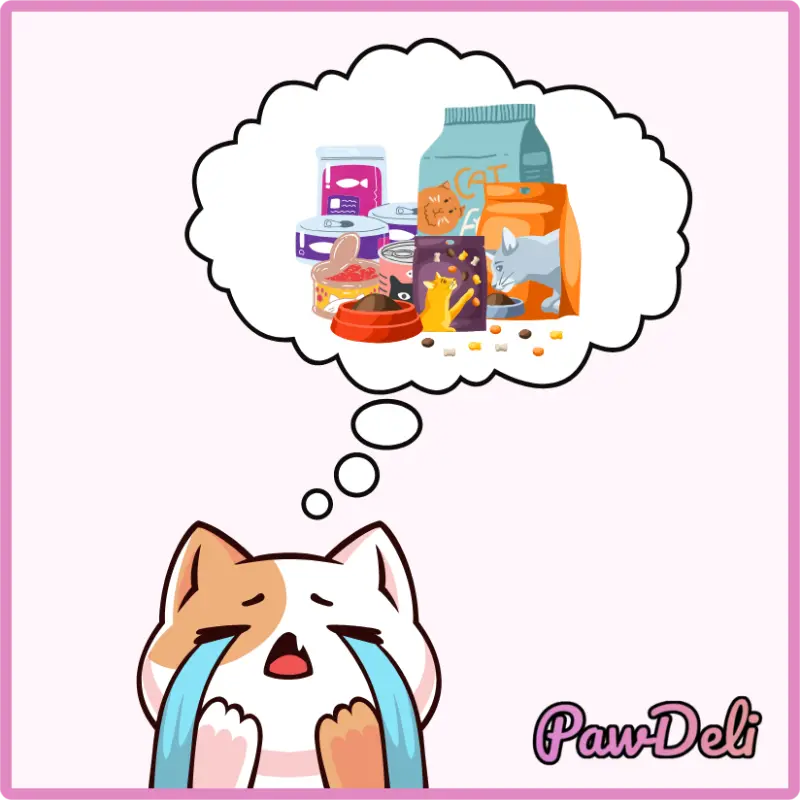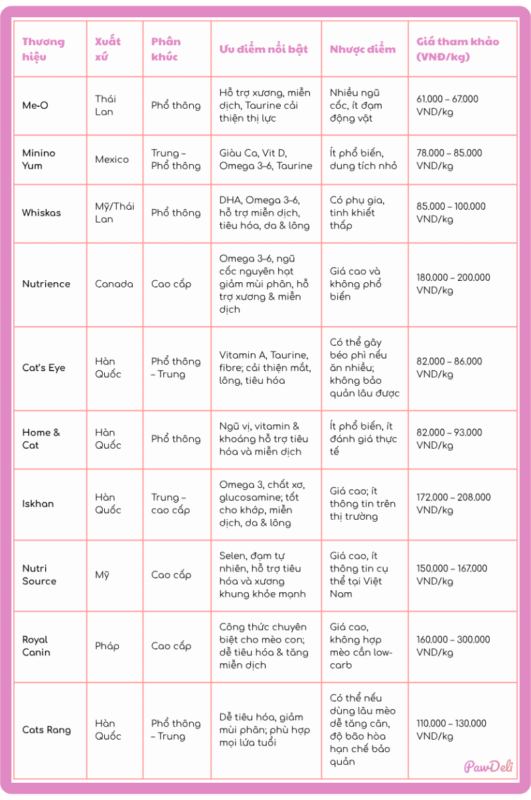Blog
Bí quyết chọn Thức ăn cho Mèo theo từng giai đoạn phát triển

Chọn thức ăn cho mèo đúng cách không chỉ giúp mèo phát triển khỏe mạnh mà còn ngăn ngừa nhiều bệnh lý nguy hiểm. Nếu bạn là một người mới, bạn càng phải hiểu rõ cách chọn thức ăn phù hợp với mèo cưng của mình.
PAWDELI dám khẳng định bạn sẽ trở thành một chuyên gia về dinh dưỡng cho mèo chỉ thông qua bài viết này, hãy đồng hành cùng chúng mình nhé!
Tại sao bạn cần biết cách chọn Thức ăn cho mèo?
Mèo là loài động vật ăn thịt bắt buộc, nên chế độ ăn của chúng phải chứa lượng protein cao từ động vật và các dưỡng chất đặc thù. Một chế độ ăn thiếu cân đối có thể dẫn đến nhiều bệnh lý như béo phì, suy thận, bệnh tim hoặc mù lòa.
Chính vì vậy, hãy coi việc chọn thức ăn cho mèo giống như chính việc bạn chọn thức ăn cho mình, không chỉ để no, mà còn cần đầy đủ dinh dưỡng.
Đọc thêm: Không nên cho mèo ăn gì? 10 loại thực phẩm cần tránh.

Các yếu tố cần xem xét khi chọn mua Thức ăn cho mèo
Chọn thức ăn cho “quàng thượng” không đơn giản chỉ là thấy hợp ví tiền là mua! Mỗi bé mèo đều có độ tuổi, sở thích và nhu cầu riêng. Để giúp các “boss” ăn ngon, khỏe mạnh và không bị rối loạn tiêu hoá hay chán ăn, bạn nên cân nhắc một vài yếu tố quan trọng trước khi thêm vào giỏ hàng nhé!
1. Dinh dưỡng cho mèo theo từng giai đoạn phát triển
- Mèo mới sinh (1 tháng tuổi): Mèo mới sinh dưới 1 tháng tuổi phải được nuôi hoàn toàn bằng sữa mẹ. Từ 4-5 tuần tuổi, có thể bắt đầu cho mèo tập ăn bằng các bữa nhỏ với tần suất 5-6 lần/ngày. Mèo mới sinh cần chế độ ăn giàu năng lượng và protein với 30-40% protein và 15-20% chất béo.
- Mèo con (dưới 1 tuổi): Mèo con cần ăn khoảng 4-5 bữa nhỏ/ngày, giảm dần xuống 3-4 bữa/ngày trong giai đoạn từ 3-6 tháng tuổi và chỉ cần 2-3 bữa/ngày trong giai đoạn 6-12 tháng tuổi.
- Mèo trưởng thành (1–7 tuổi): . Mèo trưởng thành với cân nặng trung bình sẽ cần khoảng 250 Calo/ngày để duy trì sức khỏe. Nên ăn 2 bữa chính/ngày và không ăn quá nhiều để tránh gây tăng cân.
- Mèo già (trên 7 tuổi): Cần chọn loại thực phẩm mềm, dễ tiêu hóa. Có thể cắt nhỏ trước khi cho ăn.
Ngoài nhu cầu về dinh dưỡng, PAWDELI cũng khuyến khích bạn quan tâm đến các nhu cầu sinh hoạt khác của mèo bằng cách đọc thêm bài viết Khám phá các giai đoạn phát triển của mèo từ nhỏ đến lớn.
Dưới đây là bảng số bữa ăn khuyến nghị hàng ngày dựa trên độ tuổi của mèo. Bạn hoàn toàn có thể lưu lại để dễ dàng theo dõi hơn:

2. Sở thích và thói quen ăn uống
Mỗi chú mèo đều có khẩu vị riêng. Một số thích thức ăn ướt, số khác lại chỉ thích ăn khô. Bạn nên thử từng loại để tìm ra loại thức ăn khoái khẩu nhất. Tuy nhiên hãy lưu ý rằng, dù mèo của bạn thích ăn khô hay ướt, bạn đều phải kết hợp cả hai loại thực phẩm để tránh gây ra bệnh sỏi thận.
Nếu mèo cưng của bạn thích ăn thức ăn khô, đừng quên chủ động bổ sung thật nhiều nước để bù đắp lại lượng nước bị thiếu hụt. Điều này vô cùng quan trọng, vì mèo ít có cảm giác khát, nên bạn cần giúp mèo uống đủ bằng cách đặt các bát nước bằng sứ/thủy tinh ở góc nhà (nhớ tránh xa khay cát và thay nước thường xuyên).
Nếu có điều kiện hơn nữa, bạn có thể mua máy uống nước tự động cho mèo.
3. Các chất dinh dưỡng thiết yếu
- Chất đạm (Protein) là thành phần quan trọng nhất, giúp cung cấp đầy đủ năng lượng, duy trì cơ bắp, hệ miễn dịch và các cơ quan nội tạng cho mèo (Gợi ý: Thức ăn nên có tối thiểu 30–40% protein với thức ăn khô, 8–12% với thức ăn ướt).
- Taurine cũng là một thành phần bắt buộc, nếu thiếu taurine có thể gây mù lòa, suy tim. Hãy luôn kiểm tra bao bì để đảm bảo thức ăn có chứa taurine.
- Chất béo, đặc biệt là omega-3 và omega-6 để giúp mèo giữ được bộ lông khỏe đẹp và luôn tràn đầy năng lượng (20-24% chất béo là mức tuyệt vời).
- Carbohydrate ở dạng glucose cũng rất cần thiết để mèo duy trì các chức năng sinh lý (Nên chiếm khoảng 10% Carbohydrate trong chế độ ăn)
- Vitamin và khoáng Chất bao gồm: vitamin A, B, D, E, K, cùng các khoáng chất như canxi, phốt pho, magie, sắt, kẽm… giúp mèo tăng trưởng, phát triển xương, duy trì miễn dịch và trao đổi chất.
Ngoài ra, đừng quên bổ sung nước cho “boss” nhé các Sen!
Các loại Thức ăn cho mèo phổ biến hiện nay
Sau khi đã hiểu rõ nhu cầu của mèo cưng, thì giờ là lúc hoàn hảo để lựa chọn một loại thức ăn khoái khẩu. Cùng đi shopping và thêm vào giỏ hàng nào!
1. Thức ăn khô (thức ăn hạt)
Ưu điểm: Thuận tiện, tiết kiệm chi phí, có thể để ở ngoài cho mèo ăn thoải mái trong ngày mà không bị hỏng. Ngoài ra, thức ăn khô cũng có thể bảo quản được từ 1,5-3 năm trong môi trường khô ráo, thoáng mát và tránh ánh nắng mặt trời.
Nhược điểm: Dĩ nhiên là… rất khô, nên bạn cần bổ sung nước uống thường xuyên, đừng để mèo cưng của mình khát nhé.
Lưu ý: Chọn loại thức ăn chứa nhiều protein động vật và ít carbohydrate.
2. Thức ăn ướt
Ưu điểm: Hàm lượng nước cao, dễ ăn, mùi vị hấp dẫn, mô phỏng gần giống với chế độ ăn của loài mèo trong tự nhiên.
Nhược điểm: Nhanh hỏng và không thể bảo quản được quá lâu, chỉ khoảng 3-5 ngày nếu chưa mở hộp và để trong tủ lạnh. Giá cao hơn thức ăn khô.
Lưu ý: Thức ăn ướt chỉ có khoảng 8–12% Protein vì đã chứa đến 70–80% nước.

3. Thức ăn tự làm
Ngoài các sản phẩm thức ăn cho mèo được chế biến sẵn, bạn cũng hoàn toàn có thể tự tay lên thực đơn cho “Boss”, vì không gì an toàn bằng đồ nhà làm. Tuy nhiên, bạn sẽ cần một lượng lớn kiến thức về dinh dưỡng cho mèo, cũng như tay nghề nấu ăn cao cao một chút nếu không muốn mèo cưng “chê” món bạn làm.
Điều quan trọng nhất là cần đảm bảo thức ăn phải có đầy đủ dinh dưỡng, tránh việc thiếu hụt các chất thiết yếu.
Đọc thêm: Cách làm Pate cho Mèo vừa nhanh, vừa đơn giản tại nhà.
4. Thức ăn trị liệu cho mèo
Là loại thực phẩm được thiết kế chuyên biệt để hỗ trợ tình trạng sức khỏe cụ thể của mèo, ví dụ như:
- Dị ứng thực phẩm: Sử dụng nguyên liệu thủy phân hoặc giới hạn đạm giúp hạn chế kích ứng.
- Thừa cân – béo phì: Có công thức giảm calo, giàu chất xơ giúp mèo no lâu mà vẫn đủ dưỡng chất.
- Rối loạn tiêu hóa: Giúp bổ sung prebiotic và men tiêu hóa hỗ trợ đường ruột khỏe mạnh.
- Sỏi tiết niệu, bệnh thận: Có hàm lượng khoáng cân bằng và hỗ trợ tăng lượng nước hấp thu.
- Hồi phục sau ốm: Được chế biến dưới dạng thức ăn mềm, nhiều năng lượng và dễ tiêu hóa.
Đối với loại thức ăn này, bạn đừng quên tham khảo kỹ ý kiến của bác sĩ thú y hoặc chuyên gia trước khi mua nhé!
Thức ăn trị liệu cho mèo mắc các bệnh lý đặc biệt
Giống như con người, mèo cũng có thể mắc phải nhiều bệnh lý khác nhau, từ nhẹ đến nghiêm trọng. Bên cạnh việc chăm sóc sức khỏe hàng ngày, các bé mèo cũng cần một chế độ ăn chuyên biệt, không chỉ để giúp kiểm soát tình trạng bệnh mà còn hỗ trợ phục hồi nhanh chóng.
PAWDELI sẽ đưa ra một số trường hợp cụ thể, cũng như nguyên tắc để lựa chọn thức ăn cho mèo phù hợp với từng tình trạng bệnh. Hi vọng nó có ích đối với những bé mèo không may bị bệnh.

1. Mèo bị bệnh thận
Đây là một trong những bệnh lý phổ biến nhất ở mèo lớn tuổi. Khi thận suy yếu, khả năng lọc độc tố và chuyển hoá đạm giảm đáng kể.
Nguyên tắc lựa chọn thức ăn:
- Giảm protein vừa phải nhưng vẫn đủ chất lượng (ưu tiên đạm dễ tiêu như cá hồi, gà nạc).
- Giảm hàm lượng phốt pho – vì phốt pho cao có thể khiến thận tổn thương nặng hơn.
- Tăng omega-3 để chống viêm và hỗ trợ chức năng thận.
- Thức ăn ướt là lựa chọn tốt, giúp bổ sung nước và giảm áp lực cho thận.
Theo Tổ chức International Renal Interest Society (IRIS), thức ăn cho mèo bị bệnh thận nên chứa dưới 0.5% phốt pho và protein được kiểm soát nghiêm ngặt.
2. Mèo bị béo phì hoặc cần giảm cân
Thừa cân làm tăng nguy cơ mắc tiểu đường, bệnh khớp và gan nhiễm mỡ.
Nguyên tắc lựa chọn thức ăn:
- Thức ăn giàu protein, ít carbohydrate để duy trì cơ bắp khi giảm cân.
- Chứa L-carnitine, chất hỗ trợ đốt mỡ hiệu quả đã được kiểm chứng.
- Hàm lượng calo thấp nhưng vẫn tạo cảm giác no.
- Ưu tiên loại “weight control”, “weight loss” hoặc “light formula” được chứng nhận bởi AAFCO (Hiệp hội Thức ăn chăn nuôi Hoa Kỳ).
Một số thương hiệu có dòng sản phẩm giảm cân uy tín: Royal Canin Satiety, Hill’s Metabolic, ANF Weight Management.

3. Mèo bị sỏi tiết niệu, viêm bàng quang
Nếu mèo bị tiểu khó, tiểu ra máu hoặc có tiền sử bị bênh sỏi, bạn cần đặc biệt chú ý đến chế độ dinh dưỡng.
Nguyên tắc lựa chọn thức ăn:
- Thức ăn có độ pH điều chỉnh (khoảng từ 6.2 đến 6.4) để ngăn ngừa kết tinh sỏi.
- Giảm magie, canxi, phốt pho, những khoáng chất dễ hình thành sỏi.
- Bắt buộc uống đủ nước, hãy ưu tiên thức ăn ướt, hoặc trộn hạt với nước dùng loãng.
- Không tự ý mua thức ăn trị liệu mà không hỏi ý kiến bác sĩ thú y.
Hill’s Prescription c/d Multicare hay Royal Canin Urinary S/O là các dòng phổ biến theo chỉ định bác sĩ thú y.
4. Mèo bị dị ứng thực phẩm
Dấu hiệu phổ biến bao gồm: ngứa gãi, rụng lông, tiêu chảy hoặc nôn không rõ nguyên nhân.
Nguyên tắc lựa chọn thức ăn:
- Thức ăn cho mèo chỉ chứa một nguồn đạm và tinh bột duy nhất.
- Ưu tiên protein thủy phân hoặc các loại thịt lạ ít gây dị ứng (như vịt, nai, cá trắng).
- Tránh các chất phụ gia, phẩm màu, hương liệu nhân tạo.
Bạn có thể thử các sản phẩm như: Ziwi Peak, Natural Balance Limited Ingredient, Royal Canin Hypoallergenic.
5. Mèo sau phẫu thuật hoặc đang phục hồi
Trong giai đoạn này, mèo cần được nạp năng lượng và protein chất lượng cao để tăng cường miễn dịch, làm lành vết thương và ngăn sụt cân.
Nguyên tắc lựa chọn thức ăn:
- Giàu protein động vật và chất béo tốt (omega-3, omega-6).
- Hàm lượng calo cao trong khẩu phần nhỏ, tránh làm mèo bị đầy bụng.
- Dễ tiêu hóa, mùi vị hấp dẫn để kích thích mèo ăn.
Bạn có thể cân nhắc: Royal Canin Recovery, Hill’s a/d, hoặc tự nấu súp dinh dưỡng từ ức gà, cá hồi, bí đỏ.
Cách đọc Nhãn mác và Thành phần Thức ăn cho mèo

1. Đọc 3 Thành phần đầu tiên
Kiểm tra thông tin của lượng protein có trong sản phẩm, thông thường sẽ nằm ở 3 vị trí đầu tiên trong bảng thành phần. Bảng thành phần được liệt kê theo nguyên tắc những loại chiếm tỷ lệ từ cao xuống thấp.
2. Thành phần chính cần có
Một loại thức ăn cho mèo chất lượng cao sẽ có thành phần chính là protein động vật cụ thể (ví dụ: thịt gà, gà tây, cá hồi). Thức ăn cho mèo loại tốt thường sẽ ghi rõ loại chất béo động vật được sử dụng là gì (ví dụ: mỡ gà).
TOP 10 hãng Thức ăn cho mèo tốt nhất tại Việt Nam năm 2025
Nếu bạn đang bối rối vì có quá nhiều sự lựa chọn thì đừng lo lắng, PAWDELI đã phân tích và tổng hợp bảng TOP 10 thương hiệu Thức ăn hạt cho mèo có chất lượng tốt nhất tại Việt Nam hiện nay giúp bạn có thể dễ dàng lựa chọn!
Hoặc bạn cũng có thể tham khảo ngay bài Review chi tiết các hãng Thức ăn hạt cho mèo tốt nhất năm 2025 (kèm đầy đủ ưu/nhược điểm và giá thành) để có cái nhìn tổng quan nhất.

Nên mua Thức ăn cho mèo ở đâu?
Hiện nay, nhu cầu nuôi dưỡng và chăm sóc thú cưng đã trở nên phổ biến hơn bao giờ hết. Vậy nên, bạn hoàn toàn có thể mua các sản phẩm thức ăn cho mèo một cách vô cùng dễ dàng tại các Cửa hàng thú cưng, Website hoặc các sàn thương mại điện tử uy tín như Shopee, Lazada…
Hoặc bạn cũng hoàn toàn có thể ghé thăm gian hàng của PAWDELI ngay tại https://pawdeli.com/shop hoặc Shopee (Link Shopee).
Những câu hỏi thường gặp
Dù bài viết có đầy đủ đến đâu, PAWDELI tin chắc rằng bạn hẳn vẫn sẽ có vô vàn thắc mắc trong quá trình tìm hiểu về thức ăn cho mèo cưng của mình.
Vậy nên, nếu như có bất kỳ câu hỏi nào, đừng ngần ngại liên hệ ngay với chúng mình qua Fanpage để được giải đáp trong thời gian sớm nhất nhé!
